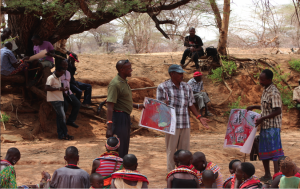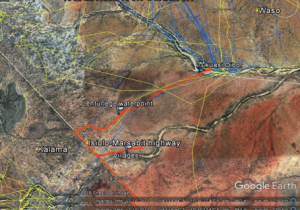Around 2 years ago, the idea of opening the northern part of the country as part of the government’s 2030 vision was becoming a reality (lappset). Construction of the high-speed railway, oil pipeline and dual carriage highway were underway. Conservation organisations aren’t against this development, however, it needs to be considered how to be approached in terms of conserving wildlife.
Action needs to be taken to ensure that wildlife, especially elephants, will still be able to roam freely and have space to do what they have been doing for centuries. This was a golden opportunity for Save the Elephants to make use of the large amounts of data that they have been collecting over the past 50+ years. STE, in conjunction with other conservation organisations in the north, started pulling elephant movement data together, as well as approaching other organisations with similar movement data e.g. Ewaso Lions, Grevys Zebra Trust and wild dog people to consolidate this issue. Since then, there has been several meetings among conservation organisations at different levels; local, national and international.
Up to now, locally and nationally, a lot of ground has been covered, for instance, a considerable number of tracking collars have been deployed for this purpose.
Despite the collaboration with other organisations and government agencies, STE has spearheaded this plan and believes there has been positive outcomes amongst local communities who reside closely to conservancies. People are ready and accepting of the idea of having corridors through community land.
A follow up meeting was organised for the 22nd February in Kalama conservancy with board members, together with local communities from one of the Kalama zones close to the corridor, to finalise this issue.
Visiting the first zone of the corridor site, Laresoro, meant it was possible to see how many villages were already there and discuss whether there were plans to permanently develop within this area e.g. build schools. It gave local people the opportunity to give testimonies on their interactions with the elephants, such as, how many people had been attacked, how many livestock had been killed and what other elephant behaviour had been observed within the area. STE spoke of the importance of the corridor, not just in reducing this on-going conflict, but in also allowing for the continued connectivity of elephant movements between different areas. This interactive meeting concluded very positively.
It was agreed that people should not move within the corridor due to an already negative interaction between the humans and elephants there. It was also understood that increasing development would only intensify conflict and stop elephants from moving between conservancies, leading to higher destruction especially of trees.
The second day of meetings visited the connecting zone, Learata. A small meeting was held with elders of a village that was positioned within the corridor who are experiencing many problems with the elephants. It was agreed that the village would be moved in order to reduce increased elephant problems and to avoid permanent settlements there in the future.
Having, by chance, attended a Nakurprat-Gotu board members meeting, the message was very clear that everyone wants the corridor to happen as a matter of urgency. It needs to be figured out how STE can spearhead this process, collaborating with KWS, other conservancies and NGOs, before over development or possession of the area means it’s too late.
The overall feeling was that communities were very positive about the preservation of elephants corridor, however, it needs to be instigated as quickly as possible. The process should continue to be done alongside involvement from the local people in surrounding conservancies to ensure that everyone understands and is in agreement.
The corridor should be incorporated into different Conservancy’s management plans. There was strong feeling that STE should employ at-least two elephants corridors ambassadors to patrol this corridors and acts as the eyes and ears of the local communities around the area into the future.
It is about time that people come together to help protect these particular areas from development and truly engage on this matter. There is a major concern about the rapid and unplanned development, not just around the highway, but along most conservation areas, for example, the huge riverside development within Nasulu. Although, not yet permanent, it is only a matter of time before major disturbances are felt by wildlife as a result of these rapid, soon to be permanent, expansions. Hopefully, the positive outcome of these meetings is the start of a collaborative effort on how to approach these major concerns.
David Explaining a corridor maps to Samburu people.
The orange line is David walking the corridor, then the blue and yellow are Annabel’s and Jordan’s tracks. This is the major Samburu-Kalama Shaba and beyond North east corridor



